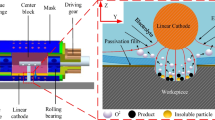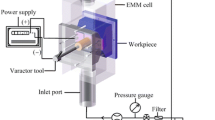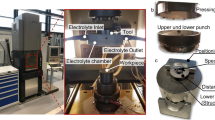Abstract
Electrochemical machining (ECM) is a powerful method to machine metals independently of their mechanical properties. Micro-sized structures can be formed with high precision. For this purpose, it is necessary to manufacture tools with adequately fine structures. Conventional ECM tools were manufactured by micro-drilling, -milling, -turning, etc. Depending on the complexity of the structures, these techniques are very elaborate and expensive. Recently, a new procedure, which combines photolithography and electroforming, the so-called PhoGaTool process (photolithographic electroforming of ECM tools), was published. In the present work, we demonstrate how this method can also be used for copying ECM tools that were conventionally manufactured. A copy of an industrial PECM tool (precise electrochemical machining) was manufactured and used for the structural characterization and determination of the replication accuracy. The electroforming parameters like deposition conditions, bath composition as well as physical and chemical parameters were optimized for model systems. The inclusion of bath additives in the metal matrix during the deposition leads to micro-stresses, hence in this contribution, an alternative additive-free electrolyte was used. The accuracy of the process was investigated by means of confocal laser scanning microscopy. Average deviations of the structure depth and the lateral structure dimensions are in the range of 5 %.
Similar content being viewed by others
References
Bannard J (1977) Electrochemical machining. J Appl Electrochem 7:1–29
McGeough JA (1974) Principles of electrochemical machining. Chapman and Hall Ltd, London
Datta M, Landolt D (1981) Electrochemical machining under pulsed current conditions. Electrochim Acta 26:899–907
Rajurkar KP, Kozak J, Wei B, McGeough JA (1993) Study of pulse electrochemical machining characteristics. CIRP Ann Manuf Technol 42:231–234
Bhattacharyya B, Malapati M, Munda J, Sarkar A (2007) Influence of tool vibration on machining performance in electrochemical micro-machining of copper. Int J Mach Tools Manuf 47:335–342
Rajurkar KP, Zhu D, McGeough JA, Kozak J, De Silva A (1999) New developments in electro-chemical machining. Ann CIRP 48(2):567–579
Weinmann M, Stolpe M, Busch R, Natter H (2015) Eletrochemical dissolution behaviour of Ti90Al6V4 and Ti60Al40 used for ECM applications. J Solid State Electrochem 19(2):485–495
Kozak J, Rajurkar KP, Makkar Y (2004) Selected problems of micro-electrochemical machining. J Mater Process Technol 149:426–431
Schuster R, Kirchner V, Allongue P, Ertl G (2000) Electrochemical micromachining. Science 289:98–101
Bhattacharyya B, Munda J, Malapati M (2004) Advancement in electrochemical micro-machining. Int J Mach Tools Manuf 44:1577–1589
Li XH, Wang ZL, Zhao WS, Hu FQ (2007) Pulsed micro-electrochemical machining technology. Key Eng Mater 339:327–331
Zhang Z, Wang Y, Chen F, Mao W (2011) A micro-machining system based on electrochemical dissolution of material. Russ J Electrochem 47:819–824
Leo Kumar SP, Jerald J, Kumanan S, Prabakaran R (2014) A review on current research aspects in tool-based micromachining processes. Mater Manuf Process 29:1291–1337
Fu WK, He N, Li L, Zhao M, Bian R (2014) Research on micromechanical drilling of micro-hole array in PVC mask. Mater Sci Forum 770:239–243
Asad ABMA, Masaki T, Rahman M, Lim HS, Wong YS (2007) Tool-based micro-machining. J Mater Process Technol 192–193:204–211
Rahman M, Asad ABMA, Wong YS (2014) Introduction to advanced machining technologies. Compr Mat Process 11:1–13
Tangwarodomnukun V, Likhitangsuwat P, Tevinpibanphan O, Dumkum C (2015) Laser ablation of titanium alloy under a thin and flowing water layer. Int J Mach Tools Manuf 89:14–28
Weinmann M, Weber O, Bähre D, Munief W, Saumer M, Natter H (2014) Photolithography-electroforming-pulse electrochemical machining: an innovative process chain for the high precision and reproducible manufacturing of complex microstructures. Int J Electrochem Sci 9:3917–3927
Natter H, Hempelmann R (2008) Nanocrystalline metals prepared by electrodeposition. Z Phys Chem 222:319–354
Natter H, Hempelmann R (2003) Tailor-made nanomaterials designed by electrochemical methods. Electrochim Acta 49:51–61
Fischer H (1973) Aspects of inhibition in electrodeposition of compact metals II. Effects of morphological interface inhibition. Electrodeposition Surf Treat 1(4):319–337
Hamann CH, Vielstich W (2005) Elektrochemie. Wiley-VCH, Weinheim
Puippe JC, Leaman F (1986) Theory and practice of pulse-plating. ASEF, Orlando
Vetter KJ, Bachmann KJ (1967) Zur Kristallisationsüberspannung. Z Phys Chem 53:9–28
Amblard J, Epelboin I, Froment M, Maurin G (1979) Inhibition and nickel electrocrystallization. J Appl Electrochem 9:233–242
Amblard J, Froment M, Maurin G, Mercier D, Trevisan-Pikacz E (1982) The electrocrystallization of nickel on vitreous carbon a kinetic and structural study of nucleation and coalescence. J Electroanal Chem Interfacial Electrochem 134(2):345–352
Amblard J, Froment M, Maurin G, Spyrellis N, Trevisan-Souteyrand E (1983) Nickel electrocrystallization—from nucleation to textures. Electrochim Acta 28:909–915
Amblard J, Froment M, Spyrellis N (1977) Origine des textures dans les depots electrolytiques de nickel. Surf Technol 5(3):205–234
Sathiyanarayanan S, Rajagopal G, Palaniswamy N, Raghavan M (2005) Corrosion protection by chemical vapor deposition: a review. Corros Rev 23(4–6):355–370
Helmersson U, Lattemann M, Bohlmark J, Ehiasarian AP, Gudmundsson JT (2006) Ionized physical vapor deposition (IPVD): a review of technology and applications. Thin Solid Films 513:1–24
Seah MP, Nunney TS (2010) Sputtering yields of compounds using argon ions. J Phys D Appl Phys 43:1–13
Larson C, Smith JR (2011) Recent trends in metal alloy electrolytic and electroless plating research: a review. T I Met Finish 6:333–341
Blink J, Farmer J, Choi J, Saw C (2009) Applications in the nuclear industry for thermal spray amorphous metal and ceramic coatings. Metall Mater Trans 40A:1344–1354
Moridi A, Hassani-Gangaraj SM, Guagliano M, Dao M (2014) Cold spray coating: review of material systems and future perspectives. Surf Eng 30(6):369–395
Natter H, Hempelmann R (1996) Nanocrystalline copper by pulsed electrodeposition: the effects of organic additives, bath temperature, and pH. J Phys Chem 100:19525–19532
Natter H, Schmelzer M, Löffler MS, Krill CE, Fitch A, Hempelmann R (2000) Grain-growth kinetics of nanocrystalline iron studied in situ by synchrotron real-time x-ray diffraction. J Phys Chem B 104:2467–2476
Warren BE, Averbach LE (1950) The effect of cold-work distortion on x-ray patterns. J Appl Phys 21:595–599
Warren BE, Averbach LE (1952) The separation of cold-work distortion and particle size broadening in x-ray patterns. J Appl Phys 23:497
Warren BE (1990) X-ray diffraction. Dover Publications, INC, New York
Krill CE III, Helfen L, Michels D, Natter H, Fitch A, Masson O, Birringer R (2001) Size-dependent grain-growth kinetics observed in nanocrystalline Fe. Phys Rev Lett 86(5):842–845
Dini JW (1993) Electrodeposition: the materials science of coatings and substrates. Noyes, Park Ridge
Author information
Authors and Affiliations
Corresponding author
Rights and permissions
About this article
Cite this article
Weißhaar, K., Weinmann, M., Jung, A. et al. Replication of microstructured tools for electrochemical machining applications. Int J Adv Manuf Technol 82, 197–209 (2016). https://doi.org/10.1007/s00170-015-7367-9
Received:
Accepted:
Published:
Issue Date:
DOI: https://doi.org/10.1007/s00170-015-7367-9




